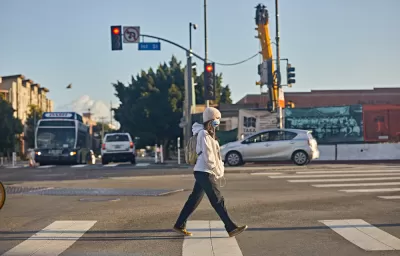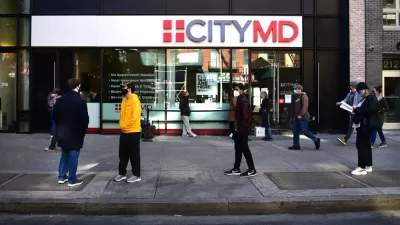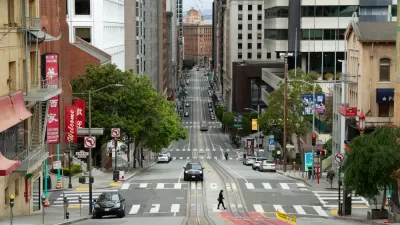The most-read news, features, and blogs on Planetizen in that year that was 2020.

Every year, Planetizen combs through analytics from 365 days of news, opinions, and analysis to produce a list of the most-read articles the year. Usually, looking back at the year in the aggregate reveals a few trends that could come as a surprise.
2020 was different, obviously, so there probably aren't a lot of surprises here. The intersection of planning and the public health crisis became obvious almost simultaneously with the announcement of stay-at-home orders, shutdowns, and plummeting transit ridership of the early days of the pandemic. Throughout the year, Planetizen correspondent Irvin Dawid kept us current with the ways public health professionals called the shots (or got shot down), and the Planetizen audience demonstrated a repeated desire to get public health news and analysis from this planning site.
I remember very clearly the first email I received from a reader about what the pandemic would mean for the future of communities and planning, and we haven't let up with the interrogation since. We're likely to be interrogating the assumptions and complications arising from the pandemic for years and even to come, and Planetizen will publishadditional in-depth analysis of how the pandemic has influenced the theory and practice of planning very soon.
Planetizen uses Google Analytics to track traffic to the site throughout the year. We used the Pageviews metric, which accounts for repeated views, to rank the popularity of these articles. There are always a few articles with staying power across the years that could have been included on this list, but this list is created for insight into relevance to developments, news, and ideas generated in the past year. For a reminder of the before times, see also the list of most and least popular articles of 2019.
This editor admits to wondering in March if there would be much planning during the pandemic. Turns out, there was more than enough. No, really. That's enough, 2020.
Feature Articles
- The Top Urban Planning Books of 2020
- Urban Planning Trends to Watch in 2020
- Top Urban Planning Websites – 2019
- The Top Urban Planning Books of 2019
- The Villages and the Dangers of Holding Too Tightly to the Past
- Jan Gehl on 60 Years of Designing Cities for People
- Twitter for Urban Planning
- Urban Planning Resources for COVID-19
- The Stage for Trump's Racist Tweet: The Villages, Florida
- I Have Spent My Career Advocating for Fair Housing. It's Good to See Obama's Rule Go.
Blog Posts
- Debating the Future of Cities, and Urban Density, After the Pandemic
- Dollar Stores and Grocery Stores
- 4 Urban Planning Fails We Need to Correct in 2020
- Planners and Pandemics: Identifying Problems and Providing Solutions
- Violence Against Black Americans a Moment of Reckoning for the Planning Profession
- 4 Predictions for Urban Planning Post-Coronavirus
- Lessons from Pandemics: Comparing Urban and Rural Risks
- Lessons from Pandemics: Transportation Risks and Safety Strategies
- 3 Cities That Will Thrive Post-Pandemic—and 2 That Might Struggle
- 4 Urban Analytics and Modeling Trends to Watch in 2020
News Articles
- And the Best City for Bicycling in the U.S. Is...
- Mississippi Governor First to Preempt Local Stay-at-Home Orders
- Census Information for Rental Property Owners
- Reopening Main Street
- Tampa Closes Streets to Open Outdoor Space to Restaurants
- Georgia Feud Over Mask Mandates May Not Be What it Seems
- Texas County First in Nation to Issue Second Stay-at-Home Order
- What's So Special About Oregon and Utah?
- Massive Widening Planned for Interstate 10 in Maricopa County
- Planned Highway Widening Requires Eminent Domain in Southern California

Trump Administration Could Effectively End Housing Voucher Program
Federal officials are eyeing major cuts to the Section 8 program that helps millions of low-income households pay rent.

Planetizen Federal Action Tracker
A weekly monitor of how Trump’s orders and actions are impacting planners and planning in America.

Ken Jennings Launches Transit Web Series
The Jeopardy champ wants you to ride public transit.

Rebuilding Smarter: How LA County Is Guiding Fire-Ravaged Communities Toward Resilience
Los Angeles County is leading a coordinated effort to help fire-impacted communities rebuild with resilience by providing recovery resources, promoting fire-wise design, and aligning reconstruction with broader sustainability and climate goals.

When Borders Blur: Regional Collaboration in Action
As regional challenges outgrow city boundaries, “When Borders Blur” explores how cross-jurisdictional collaboration can drive smarter, more resilient urban planning, sharing real-world lessons from thriving partnerships across North America.

Philadelphia Is Expanding its Network of Roundabouts
Roundabouts are widely shown to decrease traffic speed, reduce congestion, and improve efficiency.
Urban Design for Planners 1: Software Tools
This six-course series explores essential urban design concepts using open source software and equips planners with the tools they need to participate fully in the urban design process.
Planning for Universal Design
Learn the tools for implementing Universal Design in planning regulations.
Ada County Highway District
Clanton & Associates, Inc.
Jessamine County Fiscal Court
Institute for Housing and Urban Development Studies (IHS)
City of Grandview
Harvard GSD Executive Education
Toledo-Lucas County Plan Commissions
Salt Lake City
NYU Wagner Graduate School of Public Service





























